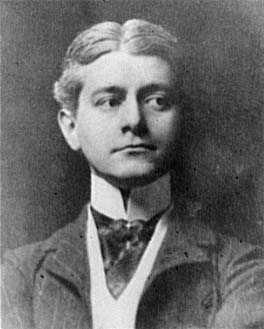Frank Norris (Benjamin Franklin Norris)

Frank Norris’s work often includes depictions of suffering caused by corrupt and greedy turn-of-the-century corporate monopolies. In The Octopus: A California Story, the Pacific and Southwest Railroad is implicated in the suffering and deaths of a number of ranchers in Southern California. At the end of the novel, after a bloody shootout between farmers and railroad agents at one of the ranches (named Los Muertos), readers are encouraged to take a “larger view” that sees that “through the welter of blood at the irrigating ditch … the great harvest of Los Muertos rolled like a flood from the Sierras to the Himalayas to feed thousands of starving scarecrows on the barren plains of India”. Though free-wheeling market capitalism causes the deaths of many of the characters in the novel, this “larger view always … discovers the Truth that will, in the end, prevail, and all things, surely, inevitably, resistlessly work together for good”. The novel Vandover and the Brute, written in the 1890s, but not published until after his death, is about three college friends preparing to become successful, and the ruin of one due to a degenerate lifestyle. In addition to Zola’s, Norris’s writing has been compared to that of Stephen Crane, Theodore Dreiser, and Edith Wharton.
Frank Norris was born in Chicago, Illinois, in 1870. His father, Benjamin, was a self-made Chicago businessman and his mother, Gertrude Glorvina Doggett, had a stage career. In 1884 the family moved to San Francisco where Benjamin went into real estate. In 1887, after the death of his brother and a brief stay in London, young Norris went to Académie Julian in Paris where he studied painting for two years and was exposed to the naturalist novels of Émile Zola. Between 1890 and 1894 he attended the University of California, Berkeley, where he became acquainted with the ideas of human evolution of Darwin and Spencer that are reflected in his later writings. His stories appeared in the undergraduate magazine at Berkeley and in the San Francisco Wave. After his parents’ divorce he went east and spent a year in the English Department of Harvard University. There he met Lewis E. Gates, who encouraged his writing. He worked as a news correspondent in South Africa (1895–96) for the San Francisco Chronicle, and then as editorial assistant for the San Francisco Wave (1896–97). He worked for McClure’s Magazine as a war correspondent in Cuba during the Spanish–American War in 1898. He joined the New York City publishing firm of Doubleday & Page in 1899.
During his time at the University of California, Berkeley, Norris was a brother in the Fraternity of Phi Gamma Delta and was an originator of the Skull & Keys society. Because of his involvement with a prank during the Class Day Exercises in 1893, the annual alumni dinner held by each Phi Gamma Delta chapter still bears his name. In 1900 Frank Norris married Jeanette Black. They had a child in 1901. Norris died on October 25, 1902, of peritonitis from a ruptured appendix in San Francisco. This left The Epic of the Wheat trilogy unfinished. He was only 32. He is buried in Mountain View Cemetery in Oakland, California. Charles Gilman Norris, the author’s younger brother, became a well regarded novelist and editor. C.G. Norris was also the husband of the prolific novelist Kathleen Norris. The Bancroft Library of the University of California, Berkeley, houses the archives of all three writers.
Born
- March, 05, 1870
- USA
- Chicago, Illinois
Died
- October, 25, 1902
- USA
- San Francisco, California
Cause of Death
- peritonitis
Cemetery
- Mountain View Cemetery
- Oakland, California
- USA


